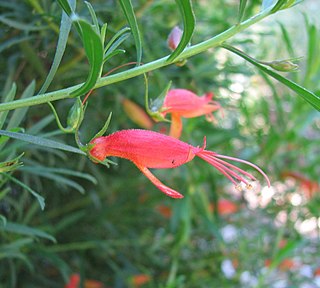
Eremophila youngii is a flowering plant in the figwort family, Scrophulariaceae and is endemic to Western Australia. It is a dense, erect shrub with many of its parts covered with a layer of grey to yellowish-grey scales and with pink, purple or red flowers.

Eremophila oldfieldii, commonly known as pixie bush, is a flowering plant in the figwort family, Scrophulariaceae and is endemic to Western Australia. It is a shrub or small tree with rough bark, broad, flat or narrow fleshy leaves and red, orange or yellow flowers.

Eremophila latrobei, commonly known as crimson turkey bush, native fuchsia, Latrobe's emu bush, grey fuchsia bush, warty fuchsia bush and Georgina poison bush is a flowering plant in the figwort family, Scrophulariaceae and is endemic to Australia. It is an erect, highly branched shrub with usually linear leaves and red to purple-red flowers and which occurs in all mainland states, including the Northern Territory but excluding Victoria.

Eremophila decipiens, commonly known as slender fuchsia bush or narrow-leaved fuchsia bush is a flowering plant in the figwort family, Scrophulariaceae and is endemic to an area extending from the south-west of Western Australia to southern parts of South Australia. It is low, sprawling shrub with lance-shaped leaves and red, orange or yellow flowers on a long, S-shaped stalk.

Eremophila denticulata, also known as toothed eremophila, toothed poverty bush and Fitzgerald eremophila, is a flowering plant in the figwort family, Scrophulariaceae and is endemic to the south-west of Western Australia. It is an erect shrub with red flowers and leaves that have toothed margins.

Eremophila hughesii is a flowering plant in the figwort family, Scrophulariaceae and is endemic to Australia. It is spindly, glabrous shrub with narrow leaves and with flowers that vary in colour from blue to pink, sometimes white. It is native to Western Australia and the Northern Territory.
Eremophila arachnoides is a plant in the figwort family, Scrophulariaceae and is endemic to a few arid areas of Western Australia and South Australia. It is a little-known, broom-shaped shrub with white to mauve, trumpet-shaped flowers which are densely hairy on the inside.

Eremophila densifolia is a flowering plant in the figwort family, Scrophulariaceae and is endemic to the south-west of Western Australia. It is usually a low, spreading shrub with densely clustered leaves and lilac to purple flowers.

Eremophila flaccida is a flowering plant in the figwort family, Scrophulariaceae and is endemic to Western Australia. It is a low, spreading shrub with sticky, shiny foliage and large, attractive flowers. There are two subspecies, one common and relatively widespread, the other known from only a few locations.

Eremophila forrestii, commonly known as Wilcox bush is a flowering plant in the figwort family, Scrophulariaceae and is endemic to Australia. It is a many-branched shrub with its branches, leaves and sepals densely-covered with a thick layer of greyish or yellowish hairs giving the plant a felty appearance. Its flowers are cream-coloured to pink and are spotted or streaked dark red. It occurs mostly in Western Australia but also in the far west of South Australia and the Northern Territory. Six subspecies are recognised by the Western Australian Government Department of Parks and Wildlife.

Eremophila jucunda is a flowering plant in the figwort family, Scrophulariaceae and is endemic to Western Australia. It is a small to medium-sized shrub with hairy branches and leaves, lance-shaped to egg-shaped leaves and cream-coloured, lilac or purple flowers.

Eremophila magnifica is a flowering plant in the figwort family, Scrophulariaceae and is endemic to Western Australia. It is an erect shrub with large, clustered leaves and large, attractive lilac-coloured or purple flowers, sometimes so densely clustered that they appear like compound heads of terminal flowers.
Eremophila petrophila is a flowering plant in the figwort family, Scrophulariaceae and is endemic to Western Australia. It is a tall, erect, open shrub with rough branches, narrow, sticky leaves and pale lilac-coloured flowers.

Eremophila phyllopoda is a flowering plant in the figwort family, Scrophulariaceae and is endemic to Western Australia. It is an erect or spreading shrub, sometimes round or flat-topped with sticky, hairy leaves and flowers ranging in colour from pink or lilac to purple.

Eremophila platythamnos, commonly known as desert foxglove, is a flowering plant in the figwort family, Scrophulariaceae and is endemic to Australia. It is an erect shrub with short, broad leaves and purple, mauve, blue or pink flowers.
Eremophila rostrata is a flowering plant in the figwort family, Scrophulariaceae and is endemic to Western Australia. It is an erect shrub with cylinder-shaped leaves, small sepals and glabrous, pink to deep red petals. There are two subspecies, both of which are critically endangered.
Eremophila shonae is a flowering plant in the figwort family, Scrophulariaceae and is endemic to Western Australia. It is an erect shrub or a low spreading shrub, depending on subspecies and has very sticky branches and leaves due to the presence of large amounts of resin. The leaves are narrow and the flowers are mauve to purple and white inside with purple spots.
Eremophila simulans is a flowering plant in the figwort family, Scrophulariaceae and is endemic to Western Australia. It is an erect shrub with broad, serrated leaves and violet to purple flowers.

Eremophila spectabilis, commonly known as showy poverty bush, is a flowering plant in the figwort family, Scrophulariaceae and is endemic to Western Australia. It is a dense, erect shrub with narrow, greyish leaves and blue, mauve or purple flowers.

Eremophila willsii is a flowering plant in the figwort family, Scrophulariaceae and is endemic to Australia. It is an erect shrub with bright green, often serrated leaves and pinkish to deep pinkish-purple petals. It is mainly found in Western Australia, the Northern Territory and South Australia in deep sand.


















